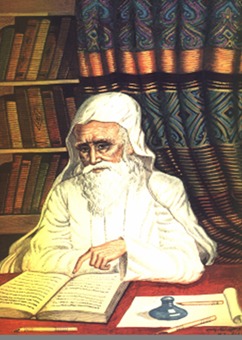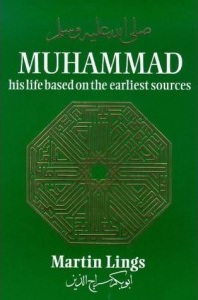
Abu Abd Allah Muhammad ibn Ishaq ibn Yasar al-Muttalibi, known simply as Ibn Ishaq, was an 8th-century Muslim historian and hagiographer. Ibn Ishaq, also known by the title ṣāḥib al-sīra, collected oral traditions that formed the basis of an important biography of the Islamic prophet Muhammad.
Abu Abd Allah Muhammad ibn Umar ibn Waqid al-Aslami (c. 130 – 207 AH; commonly referred as commonly referred to as al-Waqidi was an early Muslim historian and biographer of the Islamic prophet Muhammad, specializing in his military campaigns. His surname is derived from his grandfather's name Waqid, and thus he became famous as al-Imam al-Waqidi. He served as a judge for the Abbasid caliph al-Ma'mun. Several of al-Waqidi's works are known through his scribe and student, Ibn Sa'd.
Abu Muhammad Abd al-Malik ibn Hisham ibn Ayyub al-Himyari, known simply as Ibn Hisham, was a 9th-century Muslim historian and scholar who is known for editing the biography of Islamic prophet Muhammad written by Ibn Ishaq. He grew up in Basra, in modern-day Iraq and later moved to Egypt.

The Battle of the Trench, also known as the Battle of Khandaq and the Battle of the Confederates, was part of the conflict between the Muslims and the Quraysh, where this time the Quraysh took the offensive and advanced on the Muslims, who defended themselves in Medina by digging a trench around their settlement at the suggestion of Salman the Persian. The battle, which took place in 627 and lasted around two weeks, was lightly fought, with the Muslims reported to have suffered five to six casualties and the Quraysh three.
ʻAṣmāʼ bint Marwān a female Arab poet said to have lived in Medina in 7th-century Arabia. Early writers of Muhammad's biography claimed that she was assassinated for her agitating against Muhammad.
Abu 'Afak was a Jewish poet who allegedly lived in the Hijaz region. After Muhammad moved to the city of Al-Madina and started to preach Islam, Abu 'Afak did not convert to Islam and was vocal about his opposition to Muhammad. He became a significant political enemy of Muhammad and was subsequently assasinated by a follower of Muhammad.

The Banu Qurayza were a Jewish tribe which lived in northern Arabia, at the oasis of Yathrib. They were one of the three major Jewish tribes of the city, along with the Banu Qaynuqa and Banu Nadir. Jewish tribes reportedly arrived in Hijaz in the wake of the Jewish–Roman wars and introduced agriculture, putting them in a culturally, economically and politically dominant position. However, in the 5th century, the Banu Aws and the Banu Khazraj, two Arab tribes that had arrived from Yemen, gained dominance. When these two tribes became embroiled in conflict with each other, the Jewish tribes, now clients or allies of the Arabs, fought on different sides, the Qurayza siding with the Aws.
Zayd ibn Ḥāritha al-Kalbī, was an early Muslim, Sahabi and the adopted son of the Islamic prophet, Muhammad. He is commonly regarded as the fourth person to have accepted Islam, after Muhammad's wife Khadija, Muhammad's cousin Ali, and Muhammad's close companion Abu Bakr. Zayd was a slave that Hakim ibn Hizam, Khadija's nephew, bought for her at a market in Ukaz. Zayd then became her and Muhammad’s adopted son. Aisha the wife of the Prophet, asserts that if Zayd was to live after the Prophet he would have appointed him as Caliph.

The Battle of Mu'tah took place in September 629, between the forces of Muhammad and the army of the Byzantine Empire and their Ghassanid vassals. It took place in the village of Mu'tah in Palaestina Salutaris at the east of the Jordan River and modern-day Karak.

Jaʿfar ibn Abī Ṭālib, also known as Jaʿfar aṭ-Ṭayyār, was a companion and cousin of the Islamic prophet Muhammad, and an elder brother of Ali.
Muhammad's views on Christians were shaped through his interactions with them. Muhammad had a generally semi-positive view of Christians and viewed them as fellow receivers of Abrahamic revelation. However, he also criticised them for some of their beliefs. He sent various letters to Christian world leaders inviting them to "Submission to God, Islam". According to Islamic tradition, he interacted with Christians while in Mecca.
The historicity of Muhammad refers to the study of Muhammad as a historical figure and critical examination of sources upon which traditional accounts are based.
The early Muslim–Meccan conflict refer to a series of raids in which the Islamic prophet Muhammad and his companions participated. The raids were generally offensive and carried out to gather intelligence or seize the trade goods of caravans financed by the Mushrik of the Quraysh. His followers were also impoverished. The raids were intended to harm the economy and in turn the offensive capabilities of Mecca by Muhammad. The Muslims felt that the raids were justified in that the items being sold in the caravans were their own items, stolen by the Meccans when they had fled to Medina.
Hind bint Utba ibn Rabi'a was a dancer. She was a wife of Abu Sufyan ibn Harb and the mother of Mu'awiya I. Hind converted to Islam in 630 and is highly praised by Sunni Islamic sources for her military role at the Battle of the Yarmuk under Caliph Umar.

The siege of Banu Qurayza took place in Dhul Qa‘dah during January of 627 CE and followed on from the Battle of the Trench.
This is a timeline of the early history of Islam during the lifetime of Muhammad. The information provided in this article is based on Islamic oral tradition, not on historical or archaeological evidence. A separate list of military expeditions and battles is at List of expeditions of Muhammad.
Laylat al-mabit refers to the night in 622 CE in which the Islamic prophet Muhammad fled Mecca for Yathrib, apparently to foil an assassination plan. His escape from Mecca followed the exodus of his persecuted followers to the safe haven of Yathrib, a city that was later renamed Medina in his honor. Laylat al-mabit is often associated in Islamic literature with the reports that Muhammad's cousin Ali ibn Abi Talib risked his life to facilitate Muhammad's safe escape from Mecca.
Al-Sīrah al-Nabawiyyah also known as Siraat-e Ibn Hisham is a prophetic biography of the Islamic prophet Muhammad, written by Ibn Hisham. According to Islamic tradition, the book is an edited recension of Ibn Isḥāq's Sīratu Rasūli l-Lāh 'The Life of God's Messenger'. The work of Ibn Hishām and al-Tabari work, along with fragments by several others, are the only surviving copies of the work traditionally attributed to Ibn Ishaq. Ibn Hishām and al-Tabarī share virtually the same material.

Sirat Rasul Allah is a biography of the Islamic prophet Muhammad. Ibn Hisham published a further revised version of the book, under the same title Al-Sirah al-Nabawiyyah.







